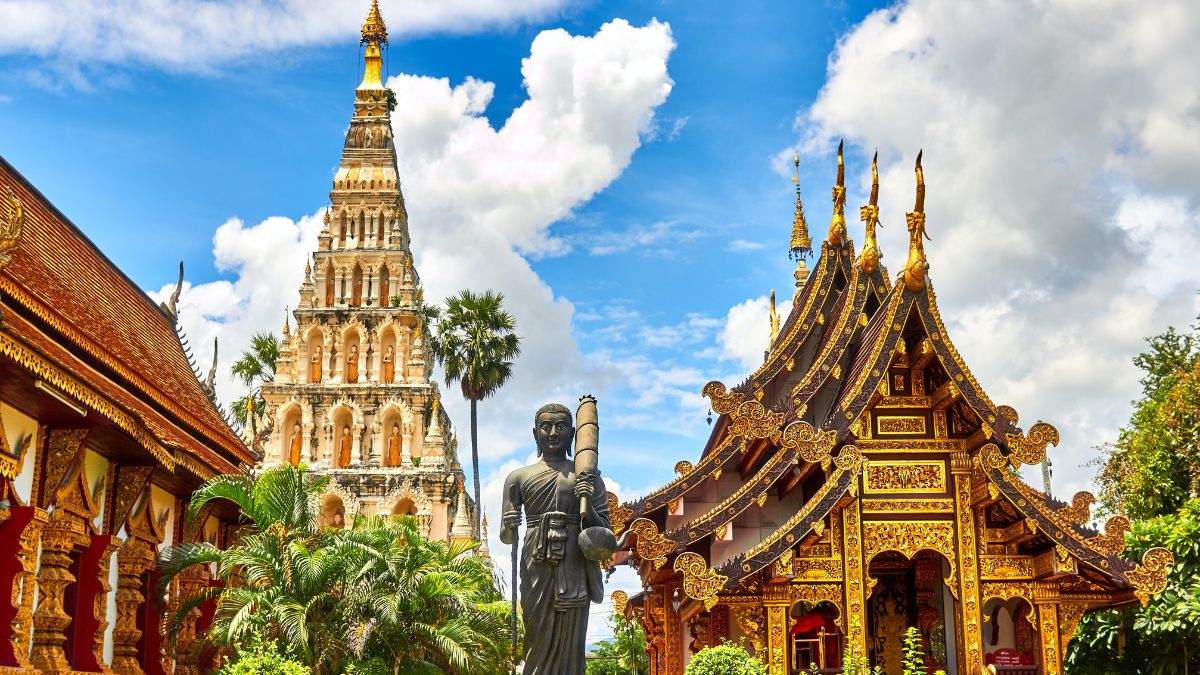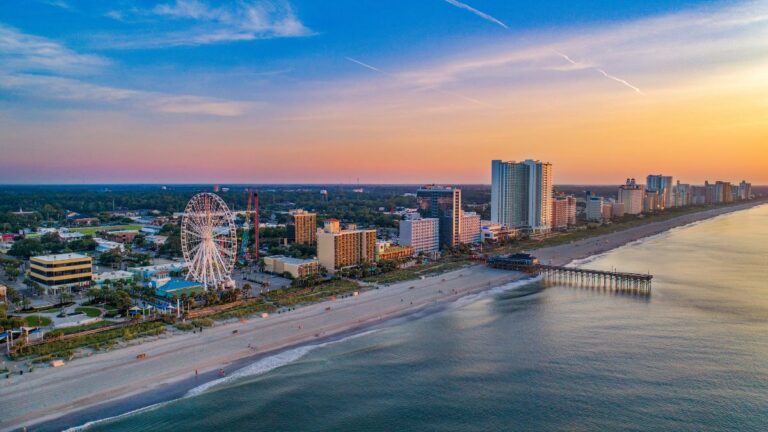Worst Time To Visit Thailand: Balancing High Temperatures and Humidity

As participants in Amazon Associates and other programs, we earn from qualifying purchases. This comes at no additional cost to you. For more details, see our Affiliate Disclosure.
Thailand is known for its stunning beaches, vibrant culture, and delicious cuisine, making it a popular tourist destination year-round. However, the tropical climate of Thailand is characterized by high temperatures and humidity that can make it challenging for travelers to enjoy the country’s attractions comfortably. Therefore, it’s essential to understand the climate patterns and weather conditions to determine the best time to visit Thailand.
Thailand experiences a tropical climate, meaning that it is hot and humid throughout the year, with occasional rainfall. However, the high temperatures and humidity levels can make it uncomfortable to explore the country’s landmarks and outdoor activities. Therefore, visitors must plan their trip according to the weather conditions to ensure that they have an enjoyable experience. In this article, we will explore the worst time to visit Thailand concerning the balance of high temperatures and humidity, providing you with the necessary information to plan your trip accordingly.
Understanding Thailand’s Climate: High Temperatures and Humidity Explained
Thailand’s climate is characterized by high temperatures and humidity, which can make it challenging for travelers to explore the country comfortably. The heat and humidity are caused by the country’s location in Southeast Asia, which is close to the equator and surrounded by warm ocean currents. The average temperature in Thailand is around 28°C (82°F), with the coastal areas being slightly cooler than the inland regions. However, the humidity levels in Thailand can make it feel much hotter, with levels averaging around 80% throughout the year.
Thailand has three main seasons: the cool season (November to February), the hot season (March to May), and the rainy season (June to October). During the cool season, temperatures can drop to around 20°C (68°F) in the northern regions of Thailand, making it a popular time for travelers to visit. The hot season, which runs from March to May, sees temperatures rise to an average of 35°C (95°F) and can be uncomfortable for many travelers.
The rainy season brings cooler temperatures, but also high humidity levels and frequent rainfall, which can affect travel plans and outdoor activities. Understanding the climate patterns in Thailand is crucial to planning a successful trip, and being prepared for the heat and humidity is key to staying comfortable during your stay.
The Best Time to Visit Thailand: A Month-by-Month Guide
Thailand is a beautiful country with a tropical climate, so it can be visited throughout the year. However, the best time to visit Thailand depends on what you want to do and see. Here are the best months to visit Thailand based on weather and popular events:
- November: The weather is pleasant, and it’s a good time to visit the northern regions of Thailand for trekking and exploring the countryside.
- December: The weather is cool and dry, making it a good time to visit Thailand’s temples, markets, and cities.
- January: The weather is dry and sunny, making it perfect for exploring the beaches, islands, and temples.
- February: The weather is dry and sunny, making it perfect for outdoor activities such as hiking, cycling, and exploring the cities.
- March: The weather in March is dry and warm, making it a good time to visit Thailand’s national parks and wildlife reserves. The famous Cherry Blossom Festival also takes place in Chiang Mai during this month.
November through March is the best time to visit Thailand when the weather is cooler and drier, making it ideal for outdoor activities and exploring the country’s various attractions.
The Worst Time to Visit Thailand: Avoiding the Hottest and Most Humid Months
The worst time to visit Thailand is during the hottest and most humid months, which are typically from April to June. The temperatures during these months can soar above 40°C (104°F), and the humidity can be oppressive, making it uncomfortable to be outdoors for extended periods.
In addition to the uncomfortable weather conditions, these months also mark the start of the monsoon season in Thailand, which can bring heavy rainfall and occasional flooding, particularly in the southern regions.
If you plan to visit Thailand during these months, you’ll need to take extra precautions to stay hydrated and cool. You may also need to adjust your itinerary to include more indoor activities and less outdoor exploration.
How to Prepare for the Heat and Humidity in Thailand: Tips and Tricks for Travelers
Thailand’s heat and humidity can be intense, especially during the hot and humid months from April to June. However, with some preparation and planning, you can stay comfortable and enjoy your trip. Here are some tips and tricks to help you prepare for the heat and humidity in Thailand:
- Dress appropriately: Wear lightweight, breathable clothing made from natural fabrics such as cotton or linen. Avoid dark colors and tight-fitting clothes that can trap heat and make you feel hotter. Wearing a hat and sunglasses can also provide some protection from the sun.
- Stay hydrated: Drink plenty of water and avoid sugary or alcoholic drinks, which can dehydrate you. Carry a reusable water bottle and refill it often. You can also buy bottled water or fresh coconut water from vendors on the street.
- Take breaks: Take frequent breaks from outdoor activities and seek shade or air-conditioned spaces. Resting in the afternoon during the hottest part of the day is a common practice in Thailand.
- Use sunscreen: Protect your skin from the sun’s harmful UV rays by wearing sunscreen with a high SPF rating. Apply it generously and frequently throughout the day, especially if you plan to be outdoors for an extended period.
- Use insect repellent: Thailand is home to many insects, including mosquitoes that can transmit diseases such as dengue fever and malaria. Use insect repellent to protect yourself from bites.
- Plan your activities wisely: Avoid strenuous activities during the hottest part of the day and plan outdoor activities for early morning or late afternoon. Consider indoor activities such as visiting museums, temples, or shopping malls during the hottest hours.
- Acclimatize yourself: Give yourself time to adjust to the heat and humidity by gradually increasing your exposure to it. Spend time outdoors and stay active, but listen to your body and take breaks when you need them.
By following these tips and tricks, you can prepare for the heat and humidity in Thailand and have a comfortable and enjoyable trip.
What to Wear in Thailand: Dressing for the Weather and Culture
Thailand has a tropical climate, so it’s important to dress for the weather and culture when visiting the country. Here are some tips on what to wear in Thailand:
- Lightweight clothing: Wear lightweight, breathable clothing made from natural fabrics such as cotton or linen. Avoid synthetic fabrics that trap heat and sweat. Loose-fitting clothes are also ideal for staying comfortable in the heat.
- Covering up: While Thailand has a relaxed attitude towards clothing, it’s important to dress modestly, especially when visiting temples or other sacred sites. You should cover your shoulders and knees, and avoid wearing revealing or tight-fitting clothing.
- Footwear: Sandals or flip flops are perfect for Thailand’s warm weather. However, if you plan to do a lot of walking or hiking, consider wearing comfortable shoes or sneakers.
- Swimwear: If you plan to visit Thailand’s beaches or swim in a pool, bring swimwear. However, it’s important to remember that public nudity is not allowed in Thailand, so be sure to cover up when leaving the beach or pool.
- Accessories: Hats, sunglasses, and scarves can provide protection from the sun and keep you cool. It’s also a good idea to bring a raincoat or umbrella during the rainy season.
- Colors: While there are no strict rules about colors in Thailand, it’s best to avoid wearing black or dark colors during the day, as they absorb heat. Instead, opt for lighter colors such as white, beige, or pastels.
- Cultural considerations: When visiting temples or other sacred sites, it’s important to dress appropriately. Women should avoid wearing skirts or dresses that are too short, and men should wear long pants instead of shorts.
Dressing for the weather and culture in Thailand is about staying comfortable and respectful. By following these tips, you can ensure that you’re dressed appropriately for your trip to Thailand.
Top Indoor Activities to Enjoy in Thailand During Hot and Humid Months
Thailand can get hot and humid, especially during the months of April to June, but there are plenty of indoor activities to enjoy to beat the heat. Here are some top indoor activities to consider during the hot and humid months:
- Visit a shopping mall: Thailand has some of the largest shopping malls in Southeast Asia, with air-conditioned environments that are perfect for escaping the heat. Malls such as Siam Paragon, CentralWorld, and EmQuartier in Bangkok, and Central Festival in Chiang Mai offer a wide range of shops, restaurants, and entertainment options.
- Explore museums and art galleries: Thailand is home to a rich cultural heritage, and exploring its museums and art galleries is a great way to learn about the country’s history and art. The Bangkok National Museum, the Jim Thompson House, and the Museum of Contemporary Art in Bangkok are just a few examples.
- Visit a spa or wellness center: Thailand is known for its spa and wellness centers, which offer a range of treatments and services, including massages, facials, and yoga classes. Pampering yourself in a spa or wellness center is a perfect way to relax and rejuvenate.
- Watch a movie: Thailand has a growing cinema industry, with many modern cinemas located in shopping malls. You can catch the latest Hollywood blockbusters or Thai movies in air-conditioned comfort.
- Learn Thai cooking: Thai cuisine is famous around the world, and learning how to cook it is a great way to immerse yourself in the country’s culture. Many cooking schools in Thailand offer classes where you can learn how to make traditional Thai dishes such as Tom Yum soup or Pad Thai.
- Play indoor sports: Thailand has many indoor sports centers where you can play games such as badminton, squash, or basketball. It’s a great way to stay active and beat the heat.
Thailand has plenty of indoor activities to enjoy during the hot and humid months. Whether you’re interested in culture, entertainment, or relaxation, there’s something for everyone.
Best Beaches in Thailand to Visit During the High-Temperature Season
Thailand is home to some of the world’s most beautiful beaches, and even during the high-temperature season, you can still enjoy the sun, sand, and sea. Here are some of the best beaches in Thailand to visit during the hot and humid months:
- Phuket: Phuket is one of Thailand’s most popular beach destinations, with over 30 beaches to choose from. Some of the most famous beaches include Patong Beach, Karon Beach, and Kata Beach. These beaches offer plenty of activities such as snorkeling, jet skiing, and parasailing.
- Krabi: Krabi is another popular beach destination in Thailand, with stunning beaches such as Railay Beach, Ao Nang Beach, and Koh Poda. These beaches offer crystal-clear waters, limestone cliffs, and opportunities for rock climbing, kayaking, and island hopping.
- Koh Samui: Koh Samui is a tropical paradise located in the Gulf of Thailand, with some of the most beautiful beaches in the country. Chaweng Beach, Lamai Beach, and Bophut Beach are just a few examples. These beaches offer a wide range of activities, from snorkeling and diving to water sports and beach parties.
- Koh Phangan: Koh Phangan is famous for its Full Moon Parties, but it also has some of the most stunning beaches in Thailand, including Haad Rin Beach, Thong Nai Pan Noi Beach, and Bottle Beach. These beaches offer white sand, crystal-clear waters, and plenty of opportunities for relaxation and adventure.
- Koh Chang: Koh Chang is one of the largest islands in Thailand, with several beautiful beaches such as White Sand Beach, Kai Bae Beach, and Lonely Beach. These beaches offer stunning views, calm waters, and plenty of activities such as kayaking, snorkeling, and hiking.
Thailand has many beautiful beaches to visit during the high-temperature season. Whether you’re looking for adventure, relaxation, or partying, there’s a beach for everyone.
The Benefits of Visiting Thailand During the Low-Tourist Season: Balancing Weather and Crowds
Thailand is a popular tourist destination year-round, but there are benefits to visiting during the low-tourist season, which is typically from July to October. Here are some of the benefits of visiting Thailand during the low-tourist season:
- Lower prices: During the low-tourist season, hotels, tours, and activities are often cheaper than during peak season. This means you can save money on your trip to Thailand and stretch your budget further.
- Fewer crowds: With fewer tourists visiting during the low season, you’ll have more space and fewer crowds to deal with at popular attractions and beaches. This can make for a more relaxing and peaceful experience.
- Cooler weather: While the low season can bring more rain and humidity, it also means cooler temperatures compared to the hot and humid months from April to June. This can make it easier to explore Thailand’s outdoor attractions, such as national parks and waterfalls.
- Local experiences: With fewer tourists around, you’ll have more opportunities to interact with locals and experience the culture and way of life in Thailand. You’ll also be able to find more authentic local food and avoid tourist traps.
- More availability: During peak season, popular hotels, tours, and activities can book up quickly, but during the low season, there’s often more availability. This means you can be more spontaneous with your travel plans and have more options to choose from.
Visiting Thailand during the low-tourist season can be a great way to balance weather and crowds. While there may be some trade-offs, such as more rain and humidity, the benefits of lower prices, fewer crowds, and cooler weather can make it a worthwhile option for many travelers.






